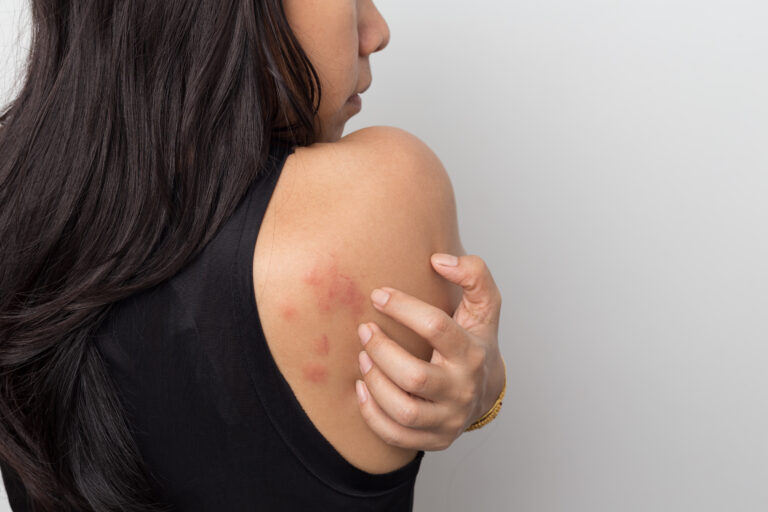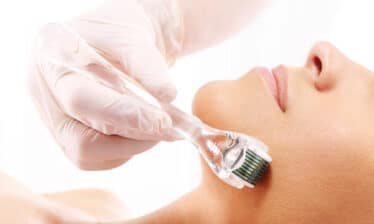Many women experience a variety of PMS symptoms ranging from bloating to back pain to painful skin rashes. They can vary from month to month and might even feel random. When it comes to experiencing PMS symptoms, however, not all are created equal, and you are not alone.
Autoimmune progesterone dermatitis is a rare skin condition that affects women of fertile age and occurs during your menstrual cycle.1 With this condition, increased progesterone levels during the luteal phase of the menstrual cycle cause inflamed skin rashes that look like eczema.
They might occur on the legs, forearms, glutes, or other areas of the body and may be mistaken for hives or other types of rashes or allergic reactions.
The rashes flare up with the menstrual cycle, usually starting a few days before your period and going away by the time your period begins.
What Causes Autoimmune Progesterone Dermatitis?
Autoimmune progesterone dermatitis generally begins in adulthood and may last for as long as you are fertile. It generally subsides in postmenopausal women. The average age that women begin experiencing symptoms is around 27 years old.2
So what causes autoimmune progesterone dermatitis? Unfortunately, this is largely unknown.
It does involve an immune response in reaction to the body’s natural production of progesterone. This might be triggered by taking oral contraceptive pills or fertility treatments containing exogenous progestogens.3 However, some women experience autoimmune progesterone dermatitis without exposure to exogenous progestogens.
Research is still being done on what causes autoimmune progesterone dermatitis.
Autoimmune Progesterone Dermatitis Symptoms
This condition is primarily a cyclic skin rash. The signs and symptoms will vary from person to person but may include:4
- Hives: A common rash causing red welts on the skin
- Erythema multiforme: A skin rash that looks like bulls-eye-shaped lesions
- Papulovesicles: A rash similar to eczema
- Annular erythema: A skin rash that starts out small and steadily grows into a bigger ring shape
- Angioedema: A swelling that occurs underneath the skin
- Mouth erosions and pruritus: Lesions and an itching sensation in the mouth
These symptoms can vary from moderate to severe and might be painful. You may experience itching alongside the rashes, and they will come and go each month with your menstrual cycle.
Some women see a reduction in symptoms during pregnancy, possibly because your body gradually increases progesterone production during pregnancy. However, adding to the frustration of this condition, some women experience worse symptoms during pregnancy, and it is not clear why.
Because the symptoms will come and go each month, you might experience some feelings of exasperation or hopelessness with finding a diagnosis. Many women are misdiagnosed with contact dermatitis, allergies, or eczema before receiving a correct diagnosis of autoimmune progesterone dermatitis. You may also notice that symptoms subside while taking an oral contraceptive pill and flare up again after discontinuing, sometimes even more severely than before.
Your doctor can determine if you have autoimmune progesterone dermatitis by noting if your skin rashes occur alongside your menstrual cycle.
They may perform intradermal testing with progesterone to see if your body reacts. This involves injecting a small amount of progesterone beneath the surface of your skin and monitoring you for an allergic response for up to 48 hours.
Your doctor might also look for improvement of your symptoms after inhibiting your progesterone production and suppressing your ovulation. This can be done with gonadotropin-releasing hormone analogs, which prevent your body from producing luteinizing hormones and ovulating.5
All of this will help your doctor to make a diagnosis and determine the appropriate treatment for you.
Autoimmune Progesterone Dermatitis Treatment
Treatment for autoimmune progesterone dermatitis will vary from person to person and depend on the severity of your symptoms.
Some treatments may include:
- Topical medications6
- Systemic corticosteroids
- Omalizumab, a monoclonal antibody that reduces inflammation7
- Hormone therapy, such as oral contraceptives or gonadotropin-releasing hormone analogs
- Surgical removal of the ovaries, in serious cases8
In general, autoimmune progesterone dermatitis cannot be treated effectively with over-the-counter antihistamines and steroids. You will need to discuss your symptoms with your healthcare provider to determine the best treatment for you.
There are some risks associated with treatments for autoimmune progesterone dermatitis. Some oral contraceptives and other hormonal treatments may cause venous thromboembolism or cause cataracts to form.9
Learn More About Autoimmune Progesterone Dermatitis
Autoimmune progesterone dermatitis is a rare skin condition involving rashes and lesions that break out regularly around your menstrual cycle. They might be painful, itchy, inflamed, or change over time.
You might not have an outbreak of any symptoms until your late twenties, and symptoms may continue through to menopause. Pregnancy may or may not help with symptoms. In some cases taking oral contraceptives or fertility treatments may have triggered your first flare-ups of the condition.
This condition can cause a lot of discomfort and frustration and will require some effort to diagnose and treat. However, treatment options are available and can address mild to severe symptoms.10 They will vary from topical medications to surgery in the most severe cases.
Always consult your healthcare provider to discuss your symptoms, go over the available treatment options, and address any questions you might have.
My Skin Treatment is here to be an online voice that helps you understand skin treatments, skin conditions, skin resurfacing lasers, laser hair removal, and any other topic related to skin care.
SOURCES:
- Allergy Asthma Immunology Research: ” A Case of Autoimmune Progesterone Dermatitis Misdiagnosed as Allergic Contact Dermatitis“
- DermNet NZ: ” Autoimmune progesterone dermatitis“
- DermNet NZ: ” Autoimmune progesterone dermatitis“
- Autoimmune Association: ” What is progesterone dermatitis“
- Allergy Asthma Immunology Research: ” A Case of Autoimmune Progesterone Dermatitis Misdiagnosed as Allergic Contact Dermatitis“
- Autoimmune Association: ” What is progesterone dermatitis“
- DermNet NZ: ” Autoimmune progesterone dermatitis”
- Cureus: ” Autoimmune Progesterone Dermatitis“
- Allergy Asthma Immunology Research: ” A Case of Autoimmune Progesterone Dermatitis Misdiagnosed as Allergic Contact Dermatitis“
- Cureus: ” Autoimmune Progesterone Dermatitis“






